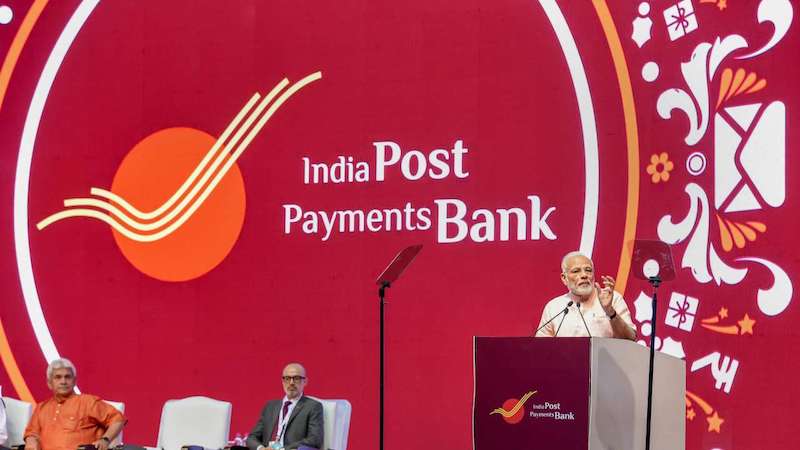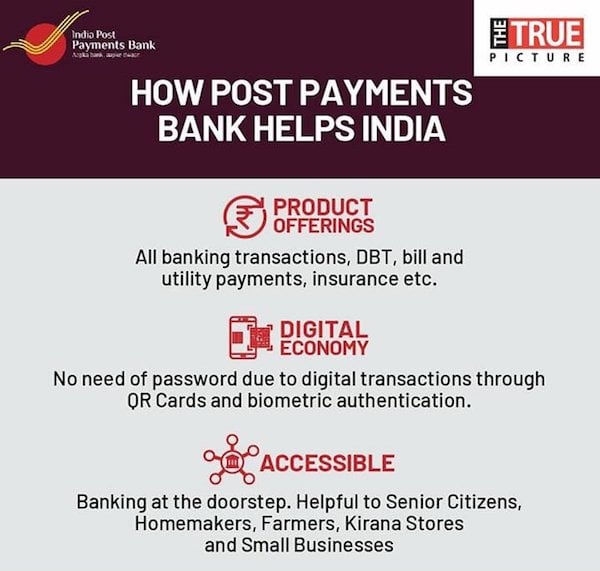After a long wait, Prime Minister Narendra Modi has finally launched the India Post Payments Bank (IPBB) with which the government is aiming to take banking to the doorstep of every citizen with the help of three lakh postmen and Grameen Dak Sewaks. These Grameen Dak Sewaks and postmen will be empowering digital financial services to the citizens. According to the information made available, IPBB will offer services through 650 branches, and 3,250 access points post the launch. However, the government has promised that the operations will be scaled to all 1.55 lakh post offices across the country by December 2018. In short, IPBB operates like any other bank, although with a smaller scale of operations without any credit risk. IPBB will offer 4% internet rate on savings account, doorstep banking services and more.

India Post Payments Bank Details
Firstly, the India Post Payments Bank will accept deposits of up to Rs 1 lakh along with remittance services, mobile payments/transfers/purchases and other banking services like ATM/debit cards, net banking and third-party fund transfers. However, it can't offer loans directly or issue credit cards. Launching the service, Prime Minister Narendra Modi said with e-mails taking over inland letters, many thought technologies had threatened the existence of the postal department and that postmen would lose their livelihood.
IPPB will leverage tech platforms, to the hilt as it will use Aadhaar to open accounts, while a QR card and biometrics will drive authentication, transactions, and payments. Grameen Dak Sewaks will be armed with smartphones and biometric devices to handle transactions. Communications Minister Manoj Sinha said deposits in any account that exceed Rs 1 lakh would be automatically converted into post office savings account.
IPPB has permission to link around 17-crore postal savings bank (PSB) accounts with its own setup. Sinha said there are about 1.4 lakh bank branches and nearly 50,000 of them are in villages, which face a challenge in reaching the unbanked.

"IPPB will transform that. To the 1.4 lakh bank branches, 1.55 lakh branches will be added now with this launch," he added. Sinha said that with the postal payments bank, people would be able to open an account in a minute with Aadhaar and biometrics.
The government-backed IPPB will compete with Airtel Payments Bank and Paytm Payments Bank. IPPB will offer products and services though multiple channels such as counter services, micro ATMs, mobile banking app, messages and interactive voice response.
It will offer a 4% interest rate on savings accounts. IPPB has teamed up with financial services providers like PNB and Bajaj Allianz Life Insurance for third-party products like loans and insurance, respectively.
Of the 1.55 lakh post offices, about 1.30 lakh are located in rural areas. IPPB is keen on tapping this network for expanding its efforts of financial inclusion and providing banking services to a hitherto untapped market.
IPPB will also facilitate digital transactions and help deliver the benefits of schemes such as Pradhan Mantri Fasal Bima Yojana, which provides assistance to farmers. "(The growing pace of) technology (in communication) threw a challenge. We used technology as a base to turn that challenge into an opportunity," he added.
Postman Will Offer Doorstep Banking Service
Noting that the postman has a special place in Indian movies and literature, he said the 'daakiya' (postman) not only delivered letters but also read them out to the families who were not literate and even replying to the letters on their behalf. He said the same postman is all set to don a new avatar, where he would provide banking services as well as promote digital literacy to the remotest parts of the country.
"We have heard the song 'Dakiya dak laya'. From now, along with dakiya dak laaya, dakiya bank bhi laaya... Dak sewaks will not only help in digital transactions but will also provide training to people so they can themselves carry out digital transactions from their phones," he said.
The postmen will not only be bankers but also digital teachers, he noted.















